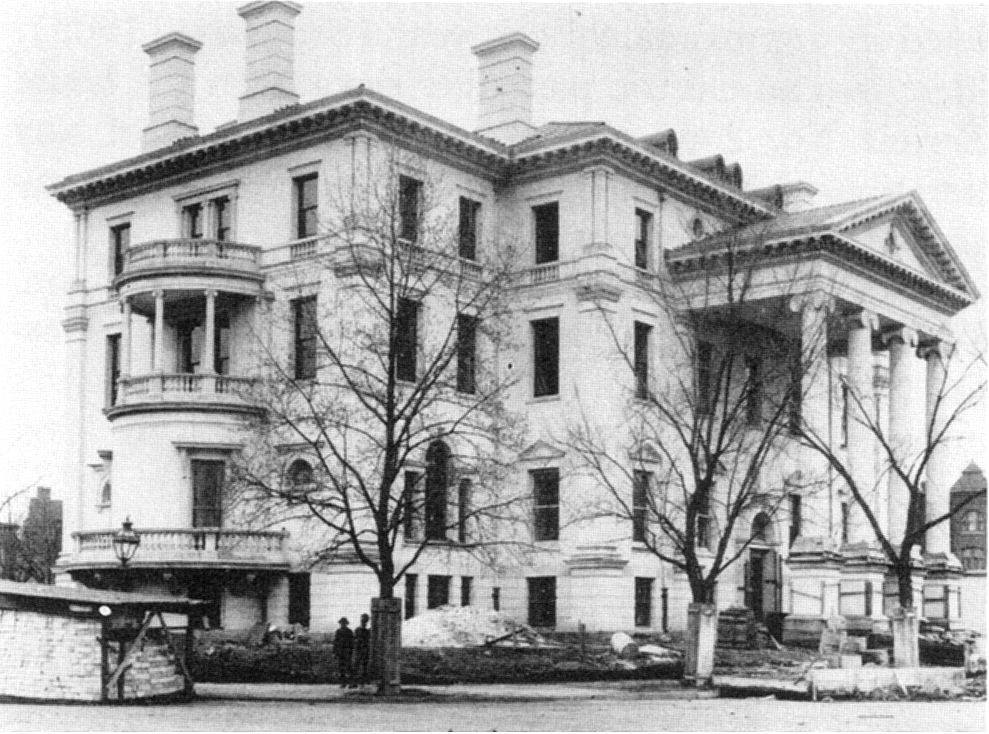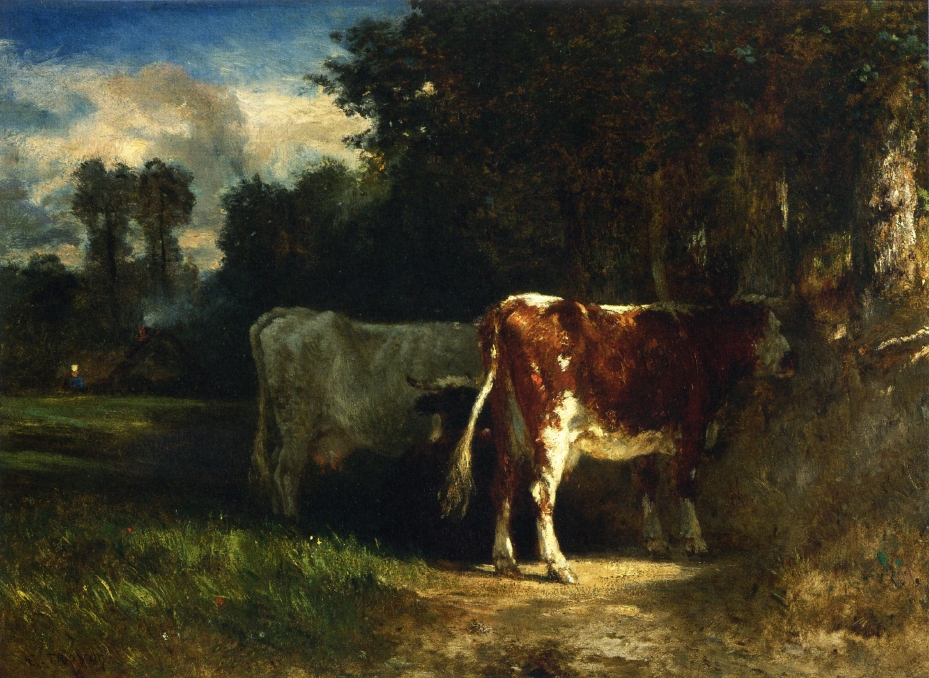
When I was writing my book about Larz and Isabel Anderson, I got to know many of the great Gilded Age mansions the couple visited during their lifetime. One of these was the Levi Z. Leiter House that until 1947 stood at 1500 New Hampshire Avenue on Dupont Circle, on a parcel of land now occupied by the Dupont Circle Hotel. Levi and his wife Mary Theresa Carver were friends of Larz’s parents, and the Leiter children, especially Mary Victoria Leiter, were friendly with Larz and Isabel. Mary Victoria became Baroness Curzon of Kedleston when she married Lord Curzon, who would later become Viceroy of India. (The Andersons’ visit with the Curzons in India is described on page 57 of my book.)

Though it was demolished in 1947, the interiors of the Leiter residence are well documented in four high-resolution photographs taken by the firm of Harris & Ewing some time before 1934, the year in which the most significant pieces of Leiter art collection were removed from the house and sold off by Levi’s children at an auction in New York. Though the family continued to occupy the house until the early 1940s, their fortune had dwindled through failed business ventures that Levi’s son Joe had gotten the family into.
When expanded to their full size, these photographs provide an intimate look at even the most mundane of objects. You can view these at your own leisure on the website of the Library of Congress. The photographs are so detailed that you can actually study the art hanging on the walls and look at wallpaper and fabric patterns!
In researching the Leiter house, I came across two valuable pieces of documentation about the art and book collections it held – before the family started selling things off. The first is the catalog for the auction “Paintings of Various Schools” held by the American Art Association and Anderson Galleries in New York in January 1934 which sold off 12 of Levi’s paintings. The second is an inventory of Mr. Leiter’s collection of rare books and manuscripts: The Leiter Library: A Catalogue of the Books, Manuscripts, and Maps…Collected by the Late Levi Ziegler Leiter.
I decided to see what I could learn about the Leiter interiors and collections by looking at the Library of Congress photographs and cross-referencing what I saw there to the auction record of the Leiter paintings sold in 1934. I found in situ photographs of several of the paintings listed in the catalog. That got me interested in finding out what had happened to all 12 paintings after they were sold.
The 1934 Auction of the Levi Leiter Collection
Here’s what I have learned about the disposition of each of the Leiter paintings sold in 1934. (Item numbers and prices are from the auction catalog linked above.)
1. Jose de Tapiró y Baró. Serenade (also known as The Musicians). “Two Arabs draped in white with a blue and pale pink headdress stand in a flowering grotto, carrying lutes.” Sold at 1934 auction for $45. Whereabouts unknown.
3. Ferdinand Victor Eugene Delacroix. Turk with Horse and Dog. “Mountain landscape with a dappled gray tied to a post and a dog with his head upon the knee of a man in turban and pantaloons seated upon a rock at right.” Sold at 1934 auction for $70. Whereabouts unknown.
7. Constantine Troyon. Two Cattle (also known as Cows). “A brown and white and a black and white cow in admirable foreshortening in the foreground of a brownish expanse of field.” Sold at 1934 auction for $40. Whereabouts unknown, but a larger format version of a painting with a similar description is in a private collection. The smaller painting in Leiter’s collection, stamped Vente Troyon on the canvas, may have been a copy from Tryon’s studio.

9. Marie Rosa Bonheur. Sheep Caught in a Thicket. “Figure of a lamb crossing the grassy foreground to the left, caught in the branches of a bramble thicket; background of blue sky.” Whereabouts unknown, but an image of a Bonheur painting of this subject appears on the internet without any identifying information about its location.

27. Pierre Étienne Théodore Rousseau. River Landscape. “Wheeltracks leading from the foreground to a broad river reflecting the blue of a wide expanse of sky with cirrus clouds; bushy trees border the water, and cattle driven by a farmhand are seen upon the road.” Sold at 1934 auction for $400. Sold by Christie’s New York in 2013 for $68,750. It is known now as Berger conduisant son troupeau [Shepherd tending his herd].

51. Narcisse Virgile Diaz de la Peña. Landscape with Hunting Dogs and Figure. “Richly wooded landscape beneath a cumulus sky, with a pond in the fore-ground and a boy in a scarlet jacket and white shirt, seated under the boughs of the trees surrounded by four bird dogs.” Sold at 1934 auction for $2,700. Sold in recent years by Schiller & Bodo New York for an undisclosed price. Now known as Boy with Four Spaniels, Fontainbleau Forest.

54. George Inness, Sr., N.A. Autumn Landscape with Cattle. “Depicting cattle wading in a stream flowing towards the left foreground, and in meadows shadowed by tall elms and oak trees in russet foliage; in the distance are farm houses and a wooded vista rising to a hill at the left.” Sold at 1934 auction for $3,600. Currently in The Preston Morton Collection, Santa Barbara Museum of Art. Now known as Morning, Catskill Valley.

55. Jean François Millet. The Knitting Lesson. “Charming figure of a little girl in blue apron and orange bonnet seated at the right, her head bent intently over the making of a sock which a peasant woman beside her is directing; dark brown background.” Sold at 1934 auction for $6,000. Now in the collection of the Saint Louis Art Museum.

65. Léon Bonnat. Arab Guardsman. “Majestic standing figure of a man looking upwards to the right, wearing a red robe with striped headdress and dark brown burnoose, and holding a rifle horizontally behind him; background of rock grotto.” Sold at 1934 auction for $630[?]. Current whereabouts unknown.
68. Louis Gallait. Italian Girl and Children at Well. “Reposeful figure of a pretty young girl with a distaff, in picturesque costume of red, white, and green, seated to half-right before an expanse of low landscape and a clear blue sky; at her feet are two naked children lying upon a white cloth.” Sold at 1934 auction for $160. Current whereabouts unknown.

71. Alexandre Cabanel. Phaedra. “Reclining figure of a nude woman partially covered with a transparent white shawl, resting her brooding head upon her right hand; seated upon a step at the foot of her couch is a sleeping servant with head thrown back.” 1934 sale price unknown. For more about this painting, see below.
85. William Bradford. Rocky Coast Scene at Daybreak. “Hazy view of distant rocky cliffs with a beach in the foreground centred by a pile of rocks and a leaning beacon.” 1934 sale price unknown. Leiter’s piece was possibly a preliminary study for a larger version in the collection of the Art Institute of Chicago.

Alexandre Cabanel’s Phaedra
The most intriguing piece in the collection was perhaps item 71, listed in the catalog as Phaedra, by the French academic-style painter, Alexandre Cabanel (1823-1889). I quickly found the painting in the collections of the Musée Fabre in Montpellier, France, Object No. 880.2.1.

The painting fit the catalog’s description almost perfectly: “Reclining figure of a nude woman partially covered with a transparent white shawl, resting her brooding head upon her right hand; seated upon a step at the foot of her couch is a sleeping servant with head thrown back.”
There were several details about the Leiter copy of the painting that differed from the Musée Fabre copy, however. For example, the Fabre’s provenance indicated that the painting was a gift of the artist to the Museum in 1880, with a notation that it had been given directly after it was exhibited at the Salon of 1880. Yet the Leiter painting was signed “Alex. Cabanel 1876.” Then, the size difference. The Fabre’s painting measures 6.3 feet high by 9.3 feet wide. Leiter’s copy was about half that size, at 3.3 feet high by 5 feet wide. I knew they could not be the same object. When I looked at the photograph of the Leiter copy in situ, the differences were immediately visible.

Since even a preliminary study of a well-known painting by a well-known artist would be collectible, I wondered where the 1876 object might have ended up. I did indeed find the painting, though not in the collection of a known museum or identified as being in a private collection. It shows up on several websites around the world that offer hand-painted oil reproductions of famous paintings.

The study version of the painting, though sharing the composition and style of the finished 1880 work, shows many differences. The servant on the right is missing, for example, and Phaedra’s face has an almost cartoonish look to it. The interior – color, decorative elements, fabrics, and more – are painted with much more attention to detail in the Fabre object. The decorative motifs on the sofa are clear, crisp, and bright. You can find many more differences on your own.
I think that each of these 12 paintings has an interesting story to tell about its “travels” once it left the auction block in 1934 in New York City. I remain hopeful that with more research I will locate the Tapiro, Delacroix, Bonheur, Bonnat, Gallait, and Bradford paintings that once were in the Leiter collection. These artists and the subjects they painted remain popular still. Some of them may have been misattributed when they were in the Leiter collection, and others may have been in private collections for so long that they are no longer remembered. But they must still exist – somewhere!


http://amzn.to/1VxLyMN